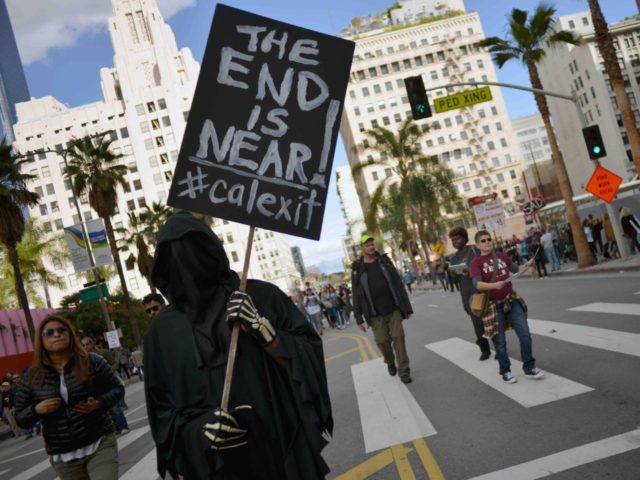“Yes California,” or #CalExit, is now collecting signatures to qualify for the 2018 ballot.
In a state that Trump lost by roughly 4 million votes, the campaign can be optimistic about hitting its minimum signature requirement of 585,407 by the July deadline. If the ballot initiative passes in 2018, a statewide vote will be held the following spring, and Californians have their say about whether they want to be an independent country.
The “Yes California” campaign touts California as a self-sufficient, economic powerhouse, prepared to go it alone: “As the sixth largest economy in the world, California is more economically powerful than France and has a population larger than Poland. Point by point, California compares and competes with countries, not just the 49 other states,” it claims
Is it safe to say #CalExit supporters will become proud nationalists after leaving? They even cite Britain’s withdrawal from the European Union, and reclaiming its sovereignty, as a flashpoint to their cause: “In 2016, the United Kingdom voted to leave the international community with their ‘Brexit’ vote.”
But the campaign focuses its complaints on California’s role in subsidizing the rest of the country:
“In our view, the United States of America represents so many things that conflict with Californian values, and our continued statehood means California will continue subsidizing the other states to our own detriment, and to the detriment of our children.”
While it is true that California receives less federal aid than most states as a percentage of revenue and per capita, this is not the whole story.
California is also $400 billion in debt, has an underfunded pension system, and relies on over $300 billion per year in federal funds. Those funds cover welfare benefits, and funding for public universities. And the state is now asking for $100 billion in federal funds for needed infrastructure projects, and repairs.
One would expect a large state, rich in natural resources, to be an economic powerhouse. California was a boom state for most of the 20th century, as millions poured in seeking opportunity.
Today, the middle class is fleeing in record numbers.
California now boasts about one-third of the nation’s welfare recipients, and only 12% of the country’s population. Yet rent, energy, local tax burdens, and housing costs have soared, while businesses have fled – over 9,000 leaving since 2008. In terms of purchasing power, California is among the costliest states. Although the state has added over 2 million jobs since the last recession, they have been mostly low-paying, service based jobs.
What that means is that California is a great place to live — if you are earning a high income, and if you can afford the housing, and the tax burden. That is, if you are not “middle class. ”
If California wants to stand on its own, it is going to have to decide if it wants to be an economic powerhouse attracting businesses and entrepreneurs – like it did in the last century. Or does it want to be a plutocracy with a small upper class, throwing scraps to masses of welfare recipients who can barely afford the rent?
The #CalExit campaign is fueled by disgruntled voters who favored Hillary Clinton over Donald Trump in last year’s election. By the time the statewide vote comes around in spring of 2019, the roster for the 2020 presidential election will be filling up. Democratic Primary debates will be a few months away, and California liberals will be looking at Sen. Elizabeth Warren (D-MA), feeling heap-big optimism.
We shall see how far that goes.
But #CalExit supporters should note that the argument for state secession cuts both ways. California is the third biggest state, with individual counties that are larger than some states. In some respects, California is six states in one. Clinton dominated the population centers around Los Angeles, San Francisco, and San Diego. But #CalExit will not be as popular in the rural, central, and eastern parts of the state.
In 1861, Virginia held a state convention, and voted to seceded from the Union. Shortly thereafter, the northwestern section of the state seceded from Virginia, and formed West Virginia.
Robert Coleman is a lawyer and writer in California. He is an alumnus of UC Berkeley and Pepperdine School of Law.

COMMENTS
Please let us know if you're having issues with commenting.